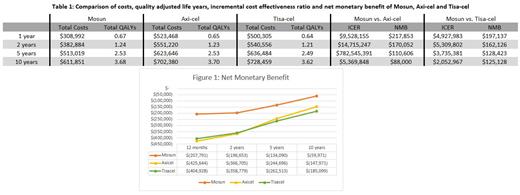Background: T cell engaging therapies including mosunetuzumab (mosun), a CD20/CD3 bispecific antibody, and two CAR-T cell products - axicabtagene ciloleucel (axi-cel) and tisagenlecleucel (tisa-cel), are FDA approved for the treatment of third line and beyond relapsed/refractory (R/R) follicular lymphoma (FL). There are no randomized comparative effectiveness trials between mosun, axi-cel and tisa-cel to guide sequencing of treatment. These products differ in their administration, hospitalization requirements, and toxicity profiles. Knowledge of relative quality-of-life and cost effectiveness may play a role in patient and clinician therapy selection.
Methods: We created a Markov model from one year to ten years from the perspective of a US payer to reflect costs and quality of life utilities associated with various health states in the course of treatment for R/R FL. Rates of complete response, partial response, days of inpatient hospitalization, incidence of toxicities such as cytokine release syndrome, neurotoxicity or neutropenia and their associated supportive care costs were derived from ZUMA-5, ELARA and Phase II mosun published data (Budde et al. Lancet Onc 2022). Additional health states in the model included re treatment with mosun if patients achieved an initial response followed by progression, palliative care or observation, other third line treatments including switch to alternative T-cell engaging therapy and death. Progression-free survival and overall survival were calibrated over a 2-year time horizon. In our base case analysis, we calculated discounted cost, quality-adjusted life-years (QALYs), and incremental cost-effectiveness ratio (ICER). We then incorporated costs and QALY to calculate the net monetary benefit (NMB) for each treatment using a willingness-to-pay threshold of $150,000 per QALY.
Results : Based on the 2-year follow up published clinical trial data, we estimated the 5 and 10-year PFS rates to be 14.41% and 2.72% at 5 and 10 years for mosun, 28.39% and 8.13% for axi-cel, and 16.59% and 3.03% for tisa-cel. In our base case analysis, the one-year total cost of mosun is $308,992, compared to $523,468 for axi-cel and $500,305 for tisa-cel (Table 1). When comparing mosun with axi-cel, mosun showed slightly improved QALY over axi-cel at years 1 and 2 (0.67 and 1.24 vs. 0.65 and 1.23, respectively), mosun and axi-cel had equivalent QALYs at 5 years (2.53), and axi-cel showing slightly improved QALY at year 10 (3.68 for mosun vs. 3.70 for axi-cel). NMB favored mosun over axi-cel at all time points with $217,853 at year 1, $170,052 at year 2, $110,606 at year 5 and $88,000 at year 10 (Figure 1). NMB favored mosun even with the slightly improved QALY at year 10 seen with axi-cel. The overall cost and QALY outcomes suggest axi-cel would cost an additional $5.4 million per QALY gained compared to mosun over this ten-year time horizon. When comparing mosun to tisa-cel, mosun showed improved costs and slightly improved QALY. NMB favored mosun over tisa-cel at all time points with $197,137 at year 1, $162,126 at year 2, $128,423 at year 5, and $125,128 at year 10. The overall cost and QALY outcomes suggest tisa-cel would cost an additional $2 million per QALY gained compared to mosun over this ten-year time horizon. Adjusting for varying response rates, toxicities, and utilities in a one-way sensitivity analysis showed that the discounted NMB per patient over time continued to favor mosun compared to both CAR-T cell products. Even assuming axi-cel and tisa-cel could be delivered as fully outpatient therapy, mosun remained cost effective at all time points over axi-cel (10 year NMB $72,004 favoring mosun) and tisa-cel (10 year NMB $119,331 favoring mosun).
Conclusions: Our model indicates that mosun is more cost-effective compared to both axi-cel and tisa-cel at 1, 2, 5 and 10 years for treatment of R/R FL. Axi-cel showed improved QALY at 10 years due to improved long term PFS, however mosun remained cost effectiveness even at the 10 year horizon. Longer term follow up of patients treated with mosun as well as real world data of ORR, PFS and OS of patients treated with CAR-T after bispecific antibodies may impact future cost effectiveness and QALY comparisons.
Disclosures
Phillips:Abbvie, AstraZeneca, Bayer, Beigene, BMS, Cardinal Health, Epizyme, Incyte, Karyopharm, Pharmacyclics, Seattle Genetics: Consultancy; Abbvie, Bayer: Research Funding. Ghosh:Bristol-Myers Squibb, Kite, Takeda, Fate, Atara, Incyte, Miltenyi.: Research Funding. Karimi:ADC therapeutics: Consultancy.


